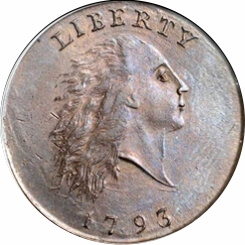Flowing Hair Large Cent Mintages
The Coinage Act of April 2, 1792, established the United States Mint and adopted the silver dollar as the foundational unit within a monetary system based on decimals. The Act authorized ten different denominations ranging from the copper half cent to the ten dollar gold eagle. Among these denominations was the cent, with a value of 1/100 of a dollar, which played a vital role in the early American economy. In 1792, patterns were created for various denominations, including the cent. However, the cents struck in the following year had a very different appearance.
The Flowing Hair Large Cent was the first series produced by the U.S. Mint for the cent denomination. Due to the design’s widespread criticism, production for the Flowing Hair Large Cent lasted only one year. However, the coin has become cherished by modern collectors and maintains its allure as one of the earliest coins officially struck within the United States.
Within its single year of issuance, the coin had two different reverse designs. The first was the Chain Reverse, created by Chief Coiner Henry Voigt. Following criticism of the initial design, Voigt quickly started working on a new design. The second rendition, the Wreath Reverse, was much more well-received and doubled the mintage of the previous design. However, the design was replaced by the Liberty Cap Large Cent the following year.
Flowing Hair Large Cent Mintages:
| Issue | Mintage |
|---|---|
| 1793 Chain Cent | 36,103 |
| 1793 Wreath Cent | 63,353 |


